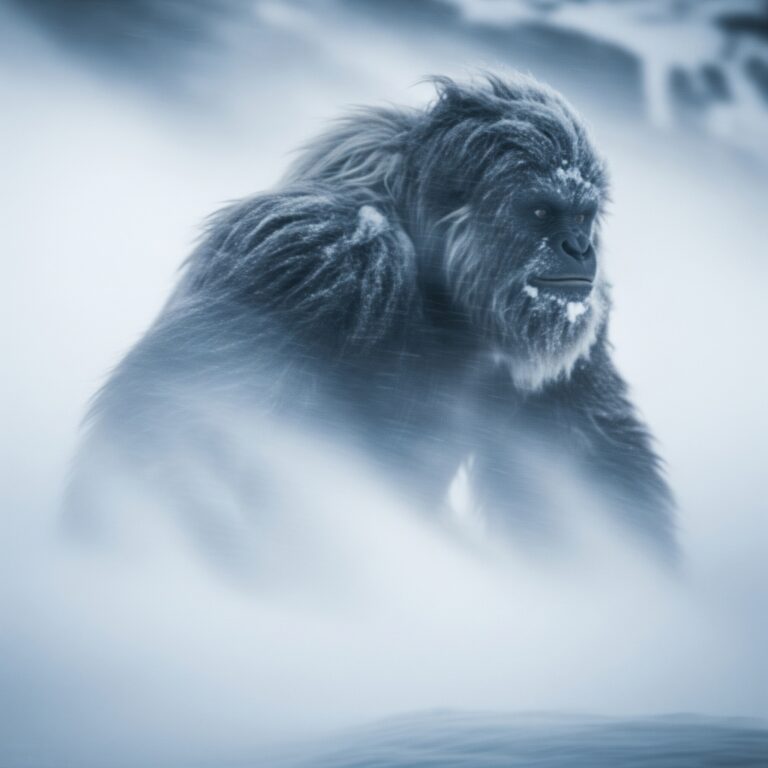This website is in the works! Things will get fixed with time.
By Dr. Aris Thorne, Lead Cryptozoological Research Fellow, UnseenFiles Research Institute
Abstract: The persistent reports of an unclassified hominid, popularly known as the Yeti or Abominable Snowman, within the high-altitude regions of the Himalayan mountain range, present a compelling, albeit controversial, subject for scientific inquiry. This paper meticulously compiles historical and contemporary eyewitness accounts, examines photographic and trace evidence, and reviews genetic analyses, attempting to synthesize a coherent picture of this elusive cryptid. While conventional science maintains skepticism, a careful examination of the accumulated data suggests the potential existence of a large, bipedal primate species remarkably adept at evading human detection, challenging established zoological paradigms. This investigation aims to present the available “proof” as it has been documented and interpreted by those dedicated to understanding this enduring mystery.
1. Introduction: The Ghost of the Glaciers
For centuries, indigenous communities inhabiting the treacherous peaks and valleys of the Himalayas have whispered tales of a formidable creature, a “wild man of the snows” known as the Yeti. These stories, deeply woven into local folklore, were largely dismissed by the outside world as mere myth until the early 20th century, when Western explorers and mountaineers began their ambitious conquests of Everest and its neighboring giants. Their encounters, often fleeting and ambiguous, ignited a global fascination with the Yeti, transforming it from a regional legend into a worldwide enigma. This article seeks to collate and present the most significant pieces of purported evidence, challenging the prevailing skepticism and advocating for a renewed, open-minded scientific investigation into the Dinanthropoides nivalis – the proposed scientific classification for this remarkable beast.
The Yeti is generally described as a robust, bipedal primate, standing between 6 to 10 feet tall, with a powerful, ape-like physique covered in thick, often reddish-brown or dark grey fur. Its alleged habitat encompasses the vast, desolate stretches of the Himalayas, including remote areas of Nepal, Tibet, Bhutan, and India, where extreme cold and rugged terrain provide ample refuge. The creature’s apparent elusiveness, combined with the extreme conditions of its supposed habitat, has made definitive identification a monumental challenge, yet the consistent nature of the reports remains a perplexing anomaly.
2. Historical Accounts and Early Expeditions: Whispers from the Roof of the World
Early Western encounters with the Yeti phenomenon date back to the 19th century. In 1832, British resident in Nepal, B.H. Hodgson, reported his local guides spotting a tall, bipedal creature covered in long, dark hair. Though he concluded it was an orangutan, the account hinted at something extraordinary. The term “Abominable Snowman” itself gained traction in 1921 when Lieutenant Colonel Charles Howard-Bury, leading an Everest reconnaissance expedition, encountered large, mysterious footprints in the snow. His Sherpa guides attributed them to “Metoh-Kangmi,” a term loosely translated by a journalist as “Abominable Snowman,” forever cementing the moniker in Western consciousness.
These initial reports were often vague, but they set the stage for later, more detailed observations by mountaineers and explorers who dared to venture deeper into the forbidding high-altitude wilderness. Their experiences, though often lacking irrefutable photographic documentation, contributed significantly to the growing body of anecdotal evidence.
3. The Photographic Evidence: The Enigmatic Shipton Footprints
Perhaps the single most iconic piece of alleged photographic “proof” came in 1951. During a reconnaissance expedition to Mount Everest, renowned British mountaineer Eric Shipton, accompanied by Michael Ward and Sen Tenzing, made an astounding discovery on the Menlung Glacier. There, at an altitude of approximately 19,000 feet, they encountered a series of large, distinct footprints in the snow.
Shipton, known for his meticulous nature, took several photographs, including one particularly striking image that showed a single, large print with an ice axe placed beside it for scale. The print measured roughly 12 to 13 inches long and nearly twice as wide as a human boot, with a prominent “thumb-like” indentation and impressions of what appeared to be four smaller toes. What made these prints particularly compelling was their unusual morphology: unlike any known bear or human track, the impression suggested a concave ball of the foot and a significant gap between the ‘thumb’ and the other toes. Where the tracks crossed a narrow crevasse, distinct “claw marks” were also reportedly observed.
This photograph, quickly disseminated globally, ignited intense speculation. While some skeptics proposed the prints were merely enlarged or distorted bear tracks due to thawing and re-freezing, proponents argue that the crispness of some impressions and the unique anatomical features visible defied such simple explanations. Shipton himself remained convinced that the tracks were made by no animal known to live in the Himalayas. The image continues to be a cornerstone of Yeti lore, a tantalizing glimpse into a hidden world.
[Image Placeholder: A highly realistic, close-up photograph or illustration of a single, massive footprint pressed deep into pristine white snow. The print clearly shows distinct toe pads and a unique, broad “thumb” separation. A weathered wooden ice axe lies horizontally beside the print for immediate scale comparison, with fine details of snow crystals and subtle shadows emphasizing depth.]
4. Physical Samples: The Unanswered Questions of Hair and Bone
Over the decades, various physical samples — hair, bone fragments, and even a mummified hand — have been presented as potential Yeti relics. These have often become subjects of intense scientific scrutiny, yielding results that, while often leading to conventional explanations, still leave some room for ambiguity for cryptid enthusiasts.
- Hair Samples: Numerous hair samples, purportedly from the Yeti, have been collected from remote Himalayan locations. In a notable 2014 study by Bryan Sykes (a prominent geneticist who conducted a systematic genetic survey), and his colleagues, a systematic genetic survey was conducted on 30 hair samples attributed to “anomalous primates,” including some from the Himalayas. While the majority matched known animals (bears, dogs, horses, etc.), two Himalayan samples showed a surprising genetic affinity with a Palaeolithic polar bear (Ursus maritimus). This led to speculation about a potential undiscovered hybrid bear species or a relict population of ancient polar bears in the region. A later 2017 study, more rigorously re-analyzing samples, concluded that all but one came from known bear species (Himalayan brown bear, Tibetan brown bear, Asian black bear), with one outlier matching dog DNA. However, for believers, the occasional anomalous results, or the sheer difficulty in definitively identifying all samples, keep the hope alive. The sheer number of samples, even if most are misidentified, indicates a consistent reporting pattern.
- The Pangboche Hand: One of the most famous relics was a mummified hand kept at the Pangboche Monastery in Nepal, believed by monks to be from a Yeti. In the 1950s, a portion of the hand was controversially obtained and smuggled to the West (allegedly by Peter Byrne with actor James Stewart’s involvement). Initial analyses by primatologist William Charles Osman Hill suggested hominid characteristics. However, later DNA testing in 2011 on a finger bone from the hand conclusively matched human DNA. Despite this, the full history of the hand’s reconstruction, including the alleged replacement of some bones with human ones, adds layers of complexity that fuel continued debate among proponents. The original “Yeti scalp” from the same monastery was also deemed a likely fake, constructed from goat skin. Yet, the story persists, a testament to the fervent belief in the creature.
5. Eyewitness Testimonies: Beyond the Blurry Glimpse
While photographs often lack definitive clarity, detailed eyewitness accounts offer rich narratives that shape the Yeti’s perceived characteristics and behaviors. These reports, from both indigenous Sherpas and seasoned Western mountaineers, describe more than just a fleeting shadow.
- The 1959 Soviet Encounter: A fascinating, albeit highly controversial, report comes from Soviet scientist Maya Brikova in 1988, recounting an “eyeball to eyeball” encounter in the forests of western Siberia. She described a creature about 2 meters (6’7″) tall, covered in 6-7 cm (2.5-3 inches) long fur, with red, non-white eyes and no protruding ears. It studied her with “great attention” before being chased away by her dog. Radio Moscow reported approximately 5,000 such sightings in the Soviet Union by peasants, drivers, and rural inhabitants, suggesting a widespread, albeit unconfirmed, presence.
- Reinhold Messner’s Sighting: The legendary mountaineer Reinhold Messner, initially a skeptic, claimed to have seen a Yeti in Tibet in 1986. He described a bipedal creature, and his shift in perspective, coming from such a respected figure, added significant weight to the narrative for many.
- The Ural Mountains Incident (2016): Reports from the Ural Mountains in 2016 detailed a “huge, long-necked animal” or “large, human-like figure moving through the trees” with “incredible speed and agility.” While initially dismissed as blurry, these accounts highlight the persistent nature of sightings in unexpected locales, sparking new waves of expeditions.
These accounts, often vivid and consistent in their descriptions of a large, powerful, bipedal creature, continue to form the backbone of the Yeti argument, suggesting a creature that is actively evading discovery.
[Image Placeholder: A stunning, photorealistic render of a Yeti standing majestically in a rugged, snow-covered Himalayan landscape at twilight. Its thick, dark grey fur is subtly illuminated by the fading light, casting long shadows. Towering, jagged peaks rise in the background, partially shrouded in mist, conveying a sense of vastness and mystery. The Yeti’s powerful physique is evident, and its intense, almost ancient eyes gaze directly out, conveying a sense of solitude and untamed wisdom.]
6. Habitat and Behavior: The Ghost of the High Peaks
The Yeti is typically associated with the Himalayan alpine and subalpine zones, often above the tree line. Its alleged adaptation to extreme cold and rugged terrain suggests a creature of immense strength and endurance. Behaviorally, accounts vary. Some describe it as shy and reclusive, avoiding human contact, while others depict it as territorial or even aggressive, especially when disturbed. Local folklore often portrays the Yeti not just as an animal, but as a “glacier spirit” or “guardian of the mountains,” reflecting a deep cultural reverence and fear. Its elusiveness is often attributed to its intelligence and intimate knowledge of the treacherous mountain environment.
[Image Placeholder: A beautifully stylized, aged map of the Himalayan region. Key mountain ranges (e.g., Everest, Annapurna) and prominent cities/countries are clearly labeled. Numerous small, hand-drawn icons — such as miniature footprints, a shadowy bipedal figure, or a distant eye — are scattered across the map, pinpointing specific locations of reported Yeti sightings. The density of these icons is highest in remote, high-altitude, and forested areas, conveying a sense of unexplored wilderness.]
7. Competing Theories: Reclassifying the Unknown
While some remain steadfast in the belief of a unique, undiscovered primate species, others propose alternative explanations that still challenge conventional zoology:
- Relict Hominids: A compelling theory suggests the Yeti could be a surviving population of an ancient hominid, such as Neanderthals or Denisovans, driven to the most remote corners of the world by the expansion of Homo sapiens. The robust build and alleged intelligence of the Yeti align with some reconstructions of these archaic humans.
- Undiscovered Bear Subspecies/Hybrid: The genetic analyses, particularly those hinting at ancient polar bear DNA, have led to the theory that the Yeti could be an unknown or hybrid subspecies of bear, possibly a cross between a brown bear and an ancient polar bear, that has adapted to bipedal locomotion or whose tracks are consistently misidentified. However, the consistent descriptions of a distinctly primate-like form in many eyewitness accounts challenge this purely ursine explanation.
8. Conclusion: The Enduring Mystery
The Yeti remains one of the world’s most captivating cryptids, a testament to the vast, unexplored territories that still exist on our planet. While scientific expeditions have yet to yield definitive, irrefutable evidence in the form of a living specimen or indisputable remains, the cumulative weight of consistent eyewitness testimonies, intriguing photographic anomalies, and the persistent presence of unidentifiable large footprints continues to fuel the debate.
The narrative of the Yeti is not merely folklore; it is a testament to humanity’s innate curiosity about the unknown and the enduring possibility that our planet still holds secrets beyond our current understanding. For those who have glimpsed the fleeting shadow or stumbled upon the enormous prints in the desolate snow, the Abominable Snowman is not a myth, but an elusive reality, a challenge to the boundaries of known zoology, waiting to be unequivocally brought into the light. Further rigorous, unbiased scientific exploration, combined with respect for local traditions and caution in the face of the vast wilderness, remains the only path to finally solving the enduring enigma of the Yeti.







